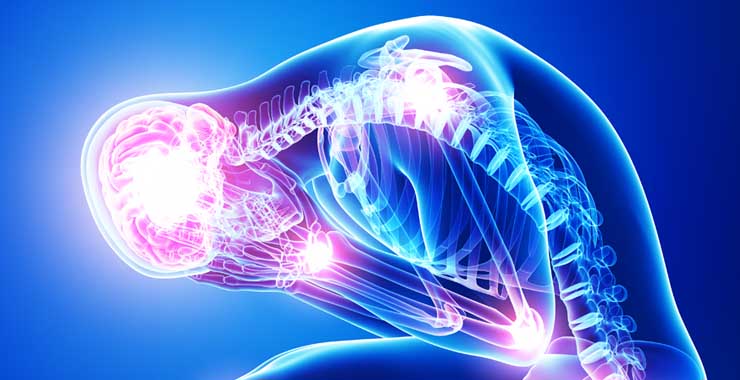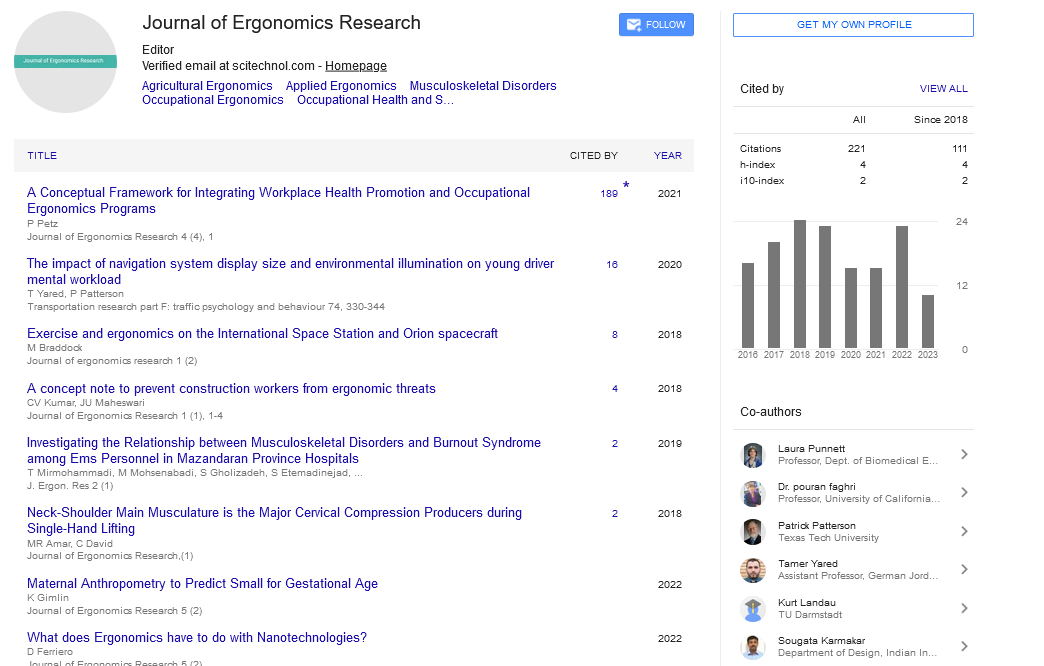About the Journal
Ergonomics is also known as human factors. It’s the way of disciplined scientific study that helps us to study and understand the human interactions with the products, equipment, environment and systems. Journal of Ergonomics Research is aimed to get ergonomists and all those fascinated to apply ergonomics/human factors in the design, planning and management of technical and social systems at work or may be at leisure. The Journal provides a platform for the up-to-date research findings in the broad area of Ergonomics like applied ergonomics, occupational ergonomics, health and safety, and also acts as a vehicle for distribution of information on ergonomics and safety related issues, developments and theories.
The journal will publish peer reviewed research including occupational ergonomics issues, not only on the aspects of prevention of investigation of work-related tasks, occupational accidents, musculoskeletal injuries, work design, disability management, cognitive engineering, legal issues and the modeling of physical or mental stress during work. This journal almost covers vast knowledge on ergonomic applications in the work place, industry, consumer products, tools, information technology and military design and also to improvise the reliable source of current information on developments in the field.
Submit manuscripts at Online Submission System or an e-mail attachment to the Editorial Office at manuscript@scitechnol.com
The Journal of Ergonomics Research also focuses on:
- Biomechanics
- Work Physiology
- Human Kinematics
- Industrial Hygiene
- Human Factors
- Safety at Work Place
- Transport Ergonomics
- Physical Education
- Agricultural Ergonomics
- Human Computer Interactions
- Applied Ergonomics
- Driver Safety
- Ergonomics Softwares
- Musculoskeletal Disorders
- Occupational Ergonomics
- Occupational Health and Safety
- Physical Ergonomics
- Environmental Ergonomics
- Ergonomics Awareness
- Industrial Ergonomics
- Automation
- Work related disorders
- Safety and Health
The Journal is an online refereed publication disseminating high quality research through original research, reviews, case reports, commentaries, opinion articles, short communications, editorials, Letter to Editor and others, etc. Journal strictly follows the peer-review process for the unbiased evaluation and publication. All the submitted manuscripts undergo peer review based on the initial quality check process and editor screening. The manuscripts qualified from quality check will be allowed for review by the subject matter expert referees, under the guidance of the Handling Editor or Editor-in-Chief of the Journal. The Journal invites potential authors to bring out novel researches in the field of ergonomics through scientific publications.
Cognitive ergonomics
Cognitive ergonomics is concerned about mental procedures; the principal spaces examined by cognitive ergonomics were nuclear power plants, aviation authority frameworks, and medicinal analgesics. Those circumstances include complex conditions (e.g., where there are numerous controls and switches-or numerous components-becoming possibly the most important factor) and where outstanding concentration is required to settle on choices in conceivably hazardous circumstances.
Applied and Social Psychology
Applied psychology is a field that spotlights on putting pragmatic research vigorously. This discipline validates psychology speculations with a specific end goal to accomplish substantial outcomes. Basic psychology is the thing that the vast majority knows as it is unadulterated research. That is, these psychologists look for information for learning and experimentation. All of academic psychology is centered on formulating or challenging hypothesis, leading controlled trials and investigating the results.
Anthropometry
The study of human individual measurements significantly on a comparative basis. Anthropometry involves the systematic measures of the physical properties of the physique, primarily dimensional descriptors of body size. It has been used for identification, for the requirements of understanding human physical variation, in anthropology and in several attempts to correlate physical with racial and psychological traits.
Biomechanics
It is the study of all the mechanical things that happens in the biological systems. Few elementary applications of Newtonian mechanics or materials sciences can accumulate perfect approximations to the mechanics of many biological aspects.
Human factors
It is the study of physical behavior of human in a particular environment. The main motto of the human factors is to decrease the errors and increase the work productivity.
Physiology
It studies about the living creatures function. It is a sub-category in biology and covers the topics of organs, biological compounds, cells, anatomy and how they all make life possible by interacting.
Kinesiology
It deals with animal and human-body movements. Operations of kinesiology in human-life involve in physical awareness instructor, health advancement, workstations, sports and workout industries. Kinesiology can afford solid establishment for graduate education in biomedical science research, in the same way health and wellness of people in all settings and public.
Occupational Hygiene
Occupational Hygiene is the method of assuming, remembering, calculating and operating health problems in the work station with the aim of protecting employs health and protecting the society at large. Occupational hygienists evaluate health hazards in a workstation sample air to conclude if there are dangerous particles present calculate noise levels in industries and provide live advice on how workers can be resisted from work-related health and safety risks.
Safety at Work Place
Plenty of work-related wounds and health problems occur because a worker is drained out and sleepy in their surroundings. Taking formal intervals helps you stay active on the job. An idea to staying alert is to schedule the many challenging tasks when your vision is best, like beginning in the morning. In case of an emergency, you’ll need swift, simple access to the outdoor.
Ergonomics Awareness
It is a way to best match materials, machinery, and work methodology with employs. The function of ergonomics must be practical. It is an advantage to employs through improving work designs and process. Accumulating the knowledge of mining organization to the advantages of implementing ergonomics allows both organization and workers to work with unity gaining profits for employs health.
Neuroergonomics
Neuroergonomics is the application of neuroscience to ergonomics. Conventional ergonomic investigations have depended to a great extent on psychological explanations of issues of human elements, for example, safety, response time, and repetitive stress injuries. Neuroimaging is currently the overwhelming procedure in social and intellectual neuroscience. We would now be able to portray the mix of various cerebrum territories as far as useful and successful availability.
Human-computer interaction (HCI)
Human-computer interaction (HCI) is the study and planned design of human and computer activities. HCI utilizes efficiency, safety and diversion to help and satisfy human-computer interaction and are connected to different kinds of computer frameworks, including air traffic control, nuclear processing, offices and computer gaming. HCI frameworks are simple, protected, viable and agreeable.
Environmental Ergonomics
Environmental Ergonomics tends to the issues of keeping up human solace, movement and wellbeing in stressful environments. Its branches of knowledge incorporate warm conditions, light, commotion and hypo-and hyperbaric environments.
Industrial ergonomics
Industrial ergonomics is the design and utilization of hardware and frameworks that don't harm industrial workers' safety or it can likewise be clarified as the investigation of adapting job tasks to human capacities and natural body developments. Ergo-Motion gives ergonomic appraisals and proposals in industrial settings, for example, producing, shipping, transportation, development, and sustenance preparing.
Work related disorders
Work-related musculoskeletal disorders (WMSD) related with repetitive and demanding working conditions keep on representing one of the most serious issues in industrialized nations. The nearness of these hazard factors created increments in the event of these wounds, in this manner making WMSDs a universal safety concern.
Musculoskeletal Disorders
Work-related MSDs associated with dreary and strenuous working conditions keep on representing one of the greatest occupational related issues in organizations. Notwithstanding the assortment of endeavours to control them, including engineering design changes, organizational modifications and working strategies preparing programs, work related musculoskeletal issue account for a tremendous measure of human enduring and to organizations and to healthcare systems.
Dental Ergonomics
Dentists develop musculoskeletal problems which are identified with suboptimal workplace ergonomics that may be in charge of inappropriate sitting postures and movements. Sitting with a 90° edge between the trunk and the thighs makes the pelvis to rotate backward shifting the spine far from the line of gravity. This thusly lessens the lumbar lordosis, making the spine slump and expanding the heaps put on the spine.
Fast Editorial Execution and Review Process (FEE-Review Process):
Journal of Ergonomics Research is participating in the Fast Editorial Execution and Review Process (FEE-Review Process) with an additional prepayment of $99 apart from the regular article processing fee. Fast Editorial Execution and Review Process is a special service for the article that enables it to get a faster response in the pre-review stage from the handling editor as well as a review from the reviewer. An author can get a faster response of pre-review maximum in 3 days since submission, and a review process by the reviewer maximum in 5 days, followed by revision/publication in 2 days. If the article gets notified for revision by the handling editor, then it will take another 5 days for external review by the previous reviewer or alternative reviewer.
Acceptance of manuscripts is driven entirely by handling editorial team considerations and independent peer-review, ensuring the highest standards are maintained no matter the route to regular peer-reviewed publication or a fast editorial review process. The handling editor and the article contributor are responsible for adhering to scientific standards. The article FEE-Review process of $99 will not be refunded even if the article is rejected or withdrawn for publication.
The corresponding author or institution/organization is responsible for making the manuscript FEE-Review Process payment. The additional FEE-Review Process payment covers the fast review processing and quick editorial decisions, and regular article publication covers the preparation in various formats for online publication, securing full-text inclusion in a number of permanent archives like HTML, XML, and PDF, and feeding to different indexing agencies.
 Spanish
Spanish  Chinese
Chinese  Russian
Russian  German
German  French
French  Japanese
Japanese  Portuguese
Portuguese  Hindi
Hindi 




